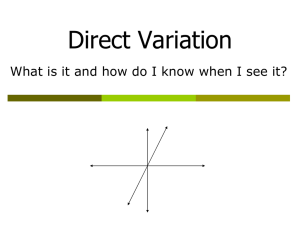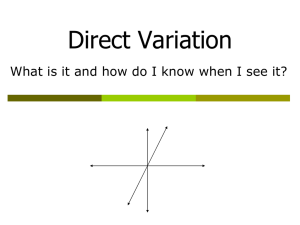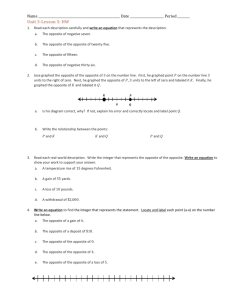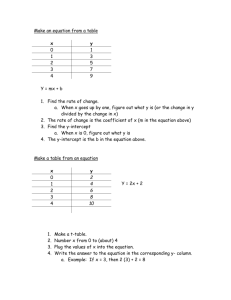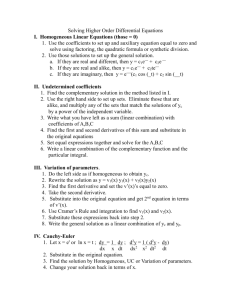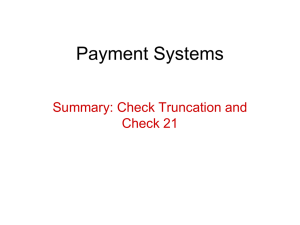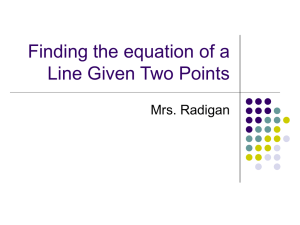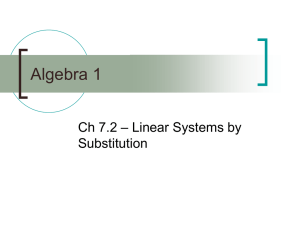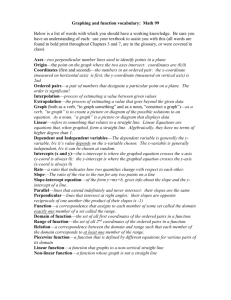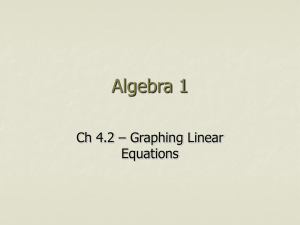Examples of Direct Variation
advertisement
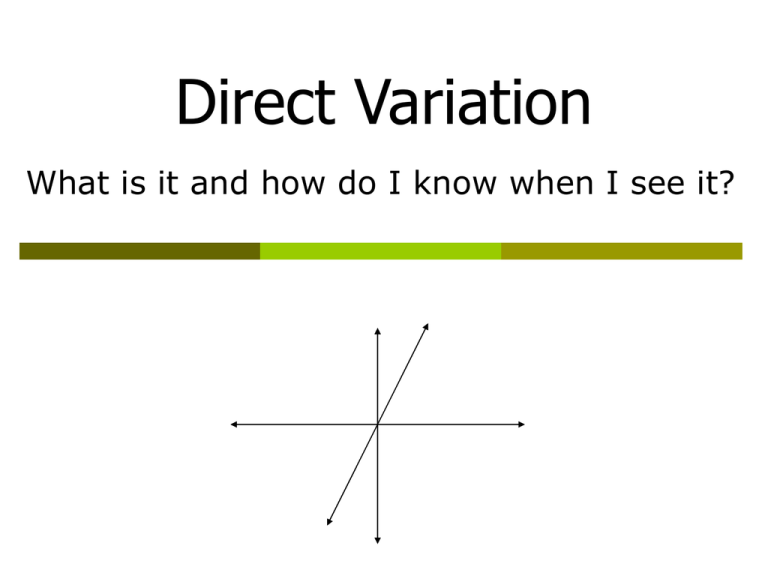
Direct Variation What is it and how do I know when I see it? What is a Direct Variation or a Direct Proportion? Used to compare two values and to see how one value affects the other value When 1 quantity always changes by the same factor (the constant) as another, the 2 quantities are in direct proportion. The 2 quantities always have equivalent ratios How do we find know if we have a direct variation? You can look at: 1. EQUATIONS 2. TABLES 3. GRAPHS to see how two values affect one another Direct Variation Equations: • Y varies directly as x means that y = kx where k is the constant of variation. • Another way of writing this is k = y x • X is the independent variable • Y is the dependent variable • K is the constant of proportionality Examples of Direct Variation Equations (y = kx)… y y y y y y = = = = = = 4x x 2x 2.5x ⅝x 0.75x k k k k k k = = = = = = 4 1 2 2.5 ⅝ 0.75 Direct Variation & Tables of Values You can make a table of values for “x” and “y” and see how the values behave. You could have a direct variation if… As “x” increases in value, “y” also increases in value OR As “x” decreases in value, “y” also decreases in value Examples of Direct Variation: X 6 7 8 Y 12 14 16 Note: As “x” increases, 6,7,8 “y” also increases. 12, 14, 16 What is the constant of variation of the table above? Start with the direct variation equation: y = kx Pick one pair of x and y values and substitute into the equation 12 = k · 6 (this is a one-step equation, so solve for k) 12/6 = k → k=2 Now you can write the equation for this direct variation: y = 2x Examples of Direct Variation: Note: X decreases, X 30 15 9 Y 10 5 3 30, 15, 9 And Y decreases. 10, 5, 3 What is the constant of variation of the table above? Start with the direct variation equation: y = kx Pick one pair of x and y values and substitute into the equation 10 = k · 30 (this is a one-step equation, so solve for k) 10/30 = k → (simplify 10/30) → k = ⅓ Now you can write the equation for this direct variation: y = ⅓ · x Is this a direct variation? If yes, give the constant of variation (k) and the equation. Yes! X 4 8 12 18 Y 6 12 18 27 y = kx •Pick an x & y pair and substitute into the direct variation equation to solve for k. •Remember the constant must hold true for every x,y pair 6=k·4 k = 6/4 = 3/2 = 1 ½ Therefore the equation for this table is: y = 1 ½ · x Is this a direct variation? If yes, give the constant of variation (k) and the equation. Yes! X 10 6 4 2 Y 25 15 10 5 y = kx * Pick an x & y pair and substitute into the direct variation equation & find k. 25 = k · 10 25/10 = k 5/2 or 2 ½ = k * Remember the constant must hold true for every x,y pair. Therefore the equation for this table is: y=2½·x Is this a direct variation? If yes, give the constant of variation (k) and the equation. No! X 15 3 1 2 Y 5 26 75 150 If you look at the values in the table, you should notice as “x” decreases, “y” increases, so you know you CANNOT have a direct variation! Also, there is no constant of proportionality. There is not one number you multiply by x to get y for each pair in the table. Which is the equation that describes the following table of values? 1. 2. 3. 4. y = -2x y = 2x y= ½x xy = 200 X 10 2 12 20 Y 5 1 6 10 Answer Now Using Direct Variation to find unknowns (y = kx) Given y varies directly with x, and y = 28 when x=7, Find x when y = 52. HOW??? 2 step process 1. Find the constant of variation X Y y = kx → 7 28 ? 52 28 = k · 7 (divide both sides by 7) k=4 2. Use y = kx. Find the unknown (x). 52= 4x or 52/4 = x x= 13 Therefore: X =13 when Y=52 Using Direct Variation to find unknowns (y = kx) Given that y varies directly with x, and y = 3 when x=9, Find y when x = 40.5. HOW??? 2 step process X Y 3=k·9 9 3 (divide both sides by 9) 40.5 ? 1. Find the constant of variation. Y = kx → K = 3/9 = 1/3 2. Use y = kx. Find the unknown (x). y= (1/3)40.5 y= 13.5 Therefore: X =40.5 when Y=13.5 Real World Examples of Direct Variation Situations… The more time I drive at a constant rate, the more miles I go. If I increase a recipe for more people, the more of an ingredient I need. The more hours I work, the more money I make. The more CD’s I purchase, the more money it costs. The less cheese I buy at the deli, the less money I pay. Using Direct Variation to solve word problems Problem: A car uses 8 gallons of gasoline to travel 290 miles. How much gasoline will the car use to travel 400 miles? Step Two: Find the constant of variation and equation: y = kx → 290 = k · 8 290/8 = k y = 36.25 x Step One: Find points in table X (gas) Y (miles) 8 290 ? 400 Step Three: Use the equation to find the unknown. 400 =36.25x 400 =36.25x 36.25 36.25 or x = 11.03 Using Direct Variation to solve word problems Problem: Step One: Find points in table. Julio wages vary directly as the number of hours that he works. If his wages for 5 hours are $29.75, how much will they be for 30 hours Step Two: Find the constant of variation. y = kx → 29.75 = k · 5 k = 5.95 X(hours) Y(wages) 5 29.75 30 ? Step Three: Use the equation to find the unknown. y = kx y = 5.95 ·30 y = 178.50 Direct Variation and Its Graph Characteristics of Direct Proportion Graph… The graph will always go through the ORIGIN (point 0,0) on the coordinate plane) & will be in Quadrants I and III only (for this year we’re only required to graph in Quadrant I – all positive numbers) The graph will always be a straight line As the “x” values increase, the “y” value will also increase Independent VS. Dependent The x-axis is the independent variable; this means it does NOT depend on the y value The y-axis is the dependent variable; this means it DOES depend on the x variable for its value. Example… You went on a hiking trip, and you graphed your distances at various times throughout your trip. As the time you hiked increased, the distance traveled also increased. The distance depends on the time; therefore, the distance is the dependent variable and it is graphed on the y-axis (vertical). The time is independent (time still goes on whether or not the distance changes), so it is graphed on the x-axis (horizontal). Tell if the following graph is a Direct Variation or not. No No No No Tell if the following graph is a Direct Variation or not. No Yes Yes No
